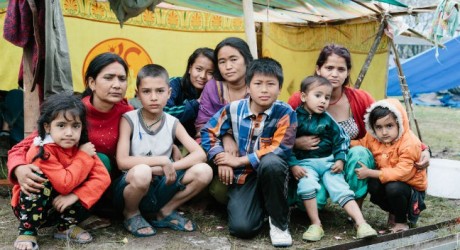In a major step to boost the health-care assistance to earthquake survivors who have been unreachable since last week’s disaster, the World Health Organization (WHO) announced the establishment of a new field office in the Gorkha district of Nepal. The field office will be established in strategic coordination with the Nepalese government and other humanitarian partners, who are also establishing operational bases in the city. From there, WHO and the national authorities will be able to coordinate land and air support to rush medicines, health care professionals and other life-saving resources to some of the most remote regions impacted by the earthquake.
Gorkha is a 3-4 hour drive northwest of the capital and has been selected as the first major health hub outside Kathmandu. It is one of the districts most affected by the earthquake, but also provides a good base from which to access other severely impacted areas. The new field office will start operating Monday and will form part of a major push by Nepalese authorities and the humanitarian sector to reach into remote, mountainous communities in urgent need of support. The new base is the first of several and will also help shore up the emergency and routine health-care services that have arrived already in the area.
“Health care services are being delivered in built-up areas in Gorkha and those that still can be reached by road,” says Hyo-Jeong Kim, WHO Emergency Operations Manager, during a 2 May field visit to the hilltop village of Katteldanda in Gorkha. The village was devastated by the earthquake.
“But we have also identified seven communities beyond the Himalayas in an area not easily accessible, and where there are about 6000 people who have not been reached with services since the earthquake struck. Below those villages, there are about 7000 additional people who have not been reached, she added.”
It is critical, Kim says, that health workers and medical supplies reach these areas immediately. “It is essential that people are treated for injuries or infections that they may have, and then protected against diarrhoeal diseases, respiratory infections and other infections to name a few. Pregnant women must also be given rapid access to care for safe deliveries and to ensure that any complication of pregnancy or birth is rapidly addressed.”
Nischal Kattel, an earthquake survivor in Katteldanda, where almost all of the 90 houses were levelled in the earthquake, says his community’s most important health needs relate to safe drinking water, sanitation and hygiene.
“We worry about the toilets. Along with the houses, most of the toilets were destroyed by the earthquake. We want to build some toilets in this area so we do not become sick,” Kattel explains while walking through his ravaged village, stepping over piles of broken bricks, snapped planks and sharp nails. “We have our own water source, but there is no safe drinking water, so we have to purify it.”
Kattel built a makeshift tent for 20 members of his family who have been cramming into it each night since the quake struck. “We are living in close quarters, and we have to be careful with our hygiene so not to get sick. People are still scared of aftershocks and want to remain outside in tents,” he said. “They are worried about their health, and they are having nightmares about the quake.”
A 15-minute drive away down a bumpy, red dirt road, is the main hospital for the district of Gorkha. The hospital workers have seen an upsurge in patients needing care for injuries, including broken bones and lacerations, along with the delivery of more regular health services, such care for children and pregnant women.
The hospital’s director, Dr Sudha Devkota, says immediately after the earthquake, the 15-bed facility was overwhelmed by injured people seeking treatment. But in the days following, hospital staff, supported by foreign medical teams from Switzerland, Spain and India, have come to grips with the caseload. But greater needs remain.
“The greatest need right now is the space for our outpatient department and pharmacy, because they have been damaged and we cannot work there. The patients need somewhere safe to be,” Dr Devkota says. “So we need tents, and thanks to WHO and the Swiss Humanitarian Aid Unit, we are receiving these.”
Care of children and pregnant women is also a priority at the hospital. In a welcome initiative, the emergency medical specialists from Switzerland, deployed as part of the WHO-coordinated foreign medical team surge response, are shifting their skills to looking after these patients, including newborn babies.
“It is very important to take care of the most vulnerable population, and that is the children,” explains Dr Olivier Hagan, of the Swiss Humanitarian Aid Unit, whose team is planning to remain at the hospital for at least one month. “That is why it is so important to focus on them, and to ensure safe deliveries. In the time we have been here, we have delivered 10 babies in the past four days. What this shows is that life goes on.” (Source WHO)














